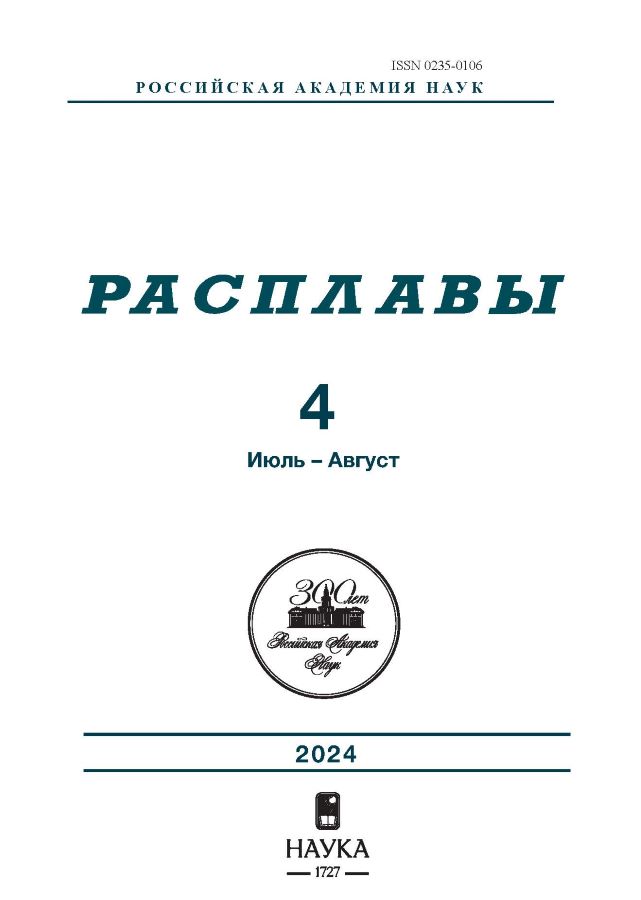The use of interphacial energies to estimate the spreading coefficients of organic liquids by the solid polymer surface of polytetrafluoroethylene
- Авторлар: Dokhov M.P.1
-
Мекемелер:
- Kabardino-Balcarian State Agrarian University named after V.M. Kokova
- Шығарылым: № 4 (2024)
- Беттер: 365-376
- Бөлім: Articles
- URL: https://rjraap.com/0235-0106/article/view/662080
- DOI: https://doi.org/10.31857/S0235010624040021
- ID: 662080
Дәйексөз келтіру
Аннотация
In the article, using equations previously obtained by the author, calculations were made of the interfacial energies of a solid polymer – polytetrafluoroethylene in contact with organic liquids and their vapors. Based on the calculation results, the spreading coefficients in the studied systems were calculated. Since Young’s derivation of the equation for the cosine of the contact angle, many researchers have attempted to determine the surface energy of solids, which would, in turn, make it possible to determine the interfacial energy at the solid-melt (liquid) interface. However, on the way to solving this problem there were obstacles associated with various processes that accompany phenomena occurring on the surface of a solid body in the presence of a liquid (melt) of another body on its surface. This is not the place to list all types of processes. They are well known to specialists in the field of surface phenomena. Here are just a few of them that affect the surface properties of bodies: chemical reactions, mutual dissolution of components of solid and liquid phases, deformation of solid phases, etc. In the case of contact of the polymer with organic liquids, such obstacles do not exist. Also, since it is impossible to dwell on all publications devoted to the determination of the surface energy of solids, the article discusses specific works on determining the interfacial energy at contact angles close to or equal to zero. Since the question of the behavior of interfacial energy at a contact angle equal to zero is of fundamental importance, and there are conflicting opinions in the literature on this matter, giving the correct answer to this question is an urgent task. Using examples of calculations of interfacial energies of homologous series of organic liquids on a solid surface of polytetrafluoroethylene, we have shown that only at zero contact angle the interfacial energy is zero. In this article, using interfacial energy values, we are the first to calculate the spreading coefficients of organic liquids over the surface of a solid polymer, which, in our opinion, is also an urgent task.
Толық мәтін
Авторлар туралы
M. Dokhov
Kabardino-Balcarian State Agrarian University named after V.M. Kokova
Хат алмасуға жауапты Автор.
Email: innagubachikova@mail.ru
Ресей, Nalchik
Әдебиет тізімі
- Volyak L.D., Stepanov V.G., Tarlakov Yu.V., Yargin V.S. O temperaturnoy zavisimosti krayevogo ugla smachivaniya [On the temperature dependence of the contact angle] / Phizicheskaya himiya granic razdela kontaktiruyushih phase (Physical chemistry of interfaces between contacting phases). Kiev: Naukova dumka. 1976. P. 124–127. [In Russian].
- Fox H.W, Zisman W.A. The Spreading of Liquids on Low Energy Surfaces. I. polytetrafluoroethylene. Journal of Colloid Science. 1950. № 5. Р. 514–531.
- Naidich Yu.V., Perevertailo V.M., Grigorenko N.F., Kapilarnye yavleniya v procesah rosta i plavleniya kristallov [Capillary phenomena in the processes of crystal growth and melting]. Kiev: Naukova dumka. 1983. [In Russian].
- Dohov M.P. Raschyot mezhfaznoi energiy nekotoryh organicheskih soedineniy na granice razdela monokristall – rasplav [Calculation of the interfacial energy of some organic compounds at the single crystal–melt interface] // Zhurnal fizicheskoi himii. 1981. 55. № 5. P. 1324–1327. [In Russian].
- Dohov M.P. Izmenenie mezhfaznih energiy tverdoe telo – rasplav i tverdoe telo – par v zavisimosti ot kraevogo ugla [Change in interfacial energies solid – melt and solid – vapor depending on the contact angle] // Izv. Vuzov: Fizika. 1985. № 7917–B.85. P. 12. [In Russian].
- Rowlinson J., Widom B. Molekulyarnaya teoriya kapillyarnosti [Molecular theory of capillarity]. M.: 1986. P. 247–257. [In Russian].
- Good R.J., Girifalco L.A. A theory for estimation of surface and interfacial energies. III. Estimation of surface energies of solids from contact angle data // The Journal of Physical Chemistry. 1960. 64 (5). P. 561–565.
- Rhee S.K. A method for determining surface energies of solids // Materials Science and Engineering.1973. 11. № 6. P. 311–318.
- Dohov M.P. K voprosu o velichine mezhfaznoi energii na granice razdela tverdoe telo – rasplav v singularnin tochkah [On the question of the magnitude of interfacial energy at the solid-melt boundary at singular points] // Rasplavy (Melts). 2022. 4. P. 362–372. [In Russian].
- Naidich Yu.V. Kontaktniye yavleniya v metallicheskih rasplavah [Contact phenomena in metal melts]. Kiev: Naukova dumka. 1972. [In Russian].
- Lipatov Yu.S. Mezhfaznye yavleniya v polumerah [Interfacial phenomena in polymers]. Kiev: Naukova dumka. 1980. [In Russian].
- Sritapunya T., Kitiyanan B., Scamehorn J., Grady B., Chavadej S. Wetting of polymer surfaces by aqueous surfactant solutions // Colloids and surfaces A. 2012. 409. P. 30–41.
- Puhova I.V., Kurzina I.A., Savkin K.P., Oskomov K.V., Oks E.M. Modifikatsiya poverkhnosti politetraftoretilena metodom ionnoy implantatsii [Modification of the surface of polytetrafluoroethylene by ion implantation] / Trudy mezhdunarodnogo mezhdistsiplinarnogo simpoziuma. Fizika poverkhnostnykh yavleniy, mezhfaznykh granits i fazovyye perekhody (Physics of surface phenomena, interphase boundaries and phase transitions.). 2015. 5. P. 185–188. [In Russian].
- Zisman W.A. Relation of the Equilibruium Contact Angle to Liquid and Solid Constitution // Advances in chemistry series. 1964. 43. P. 1–51.
- Pugachevich P.P., Beglyarov E.M., Lavigin I.A. Poverhnostniye yavleniya v polimerah [Surface phenomena in polymers]. M: Himiya. 1982. [In Russian].
Қосымша файлдар









